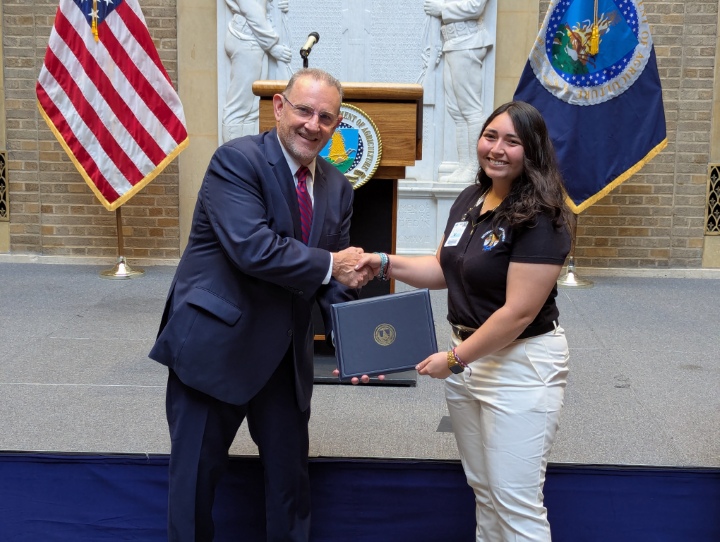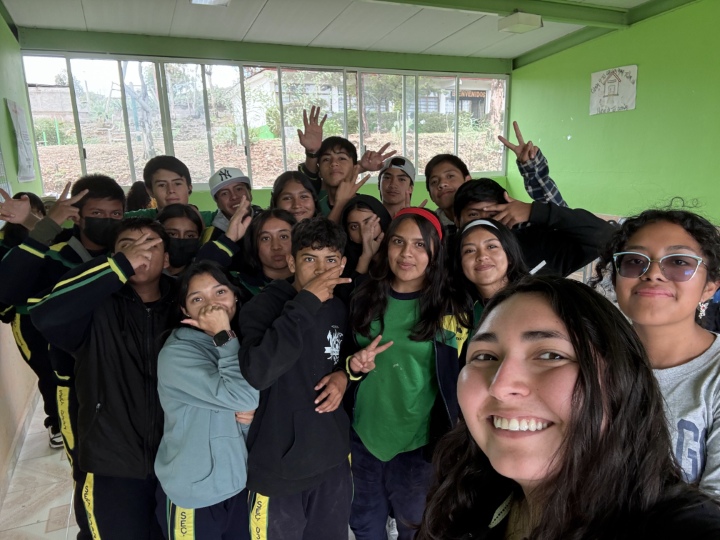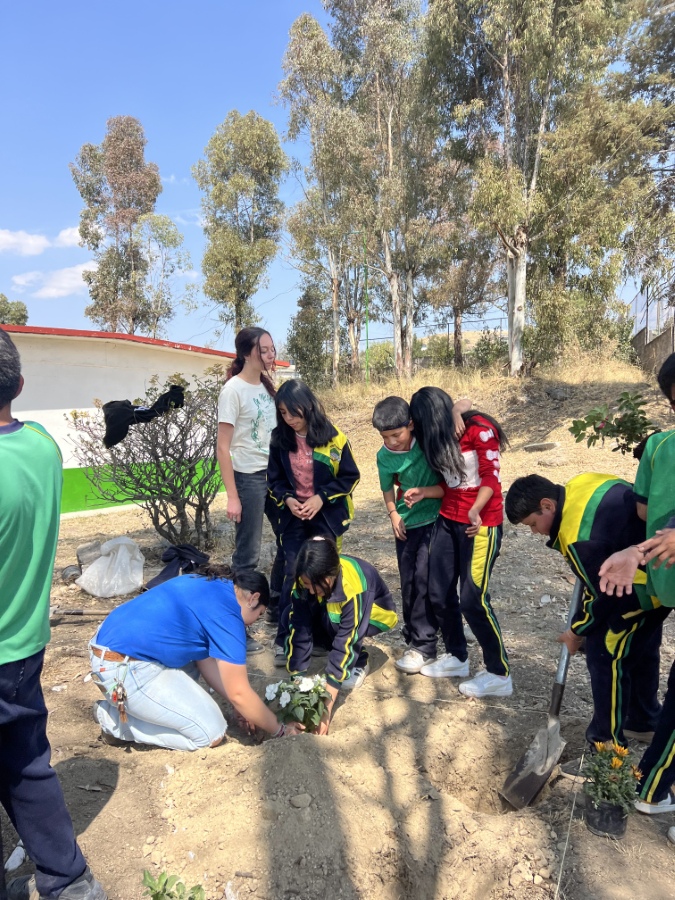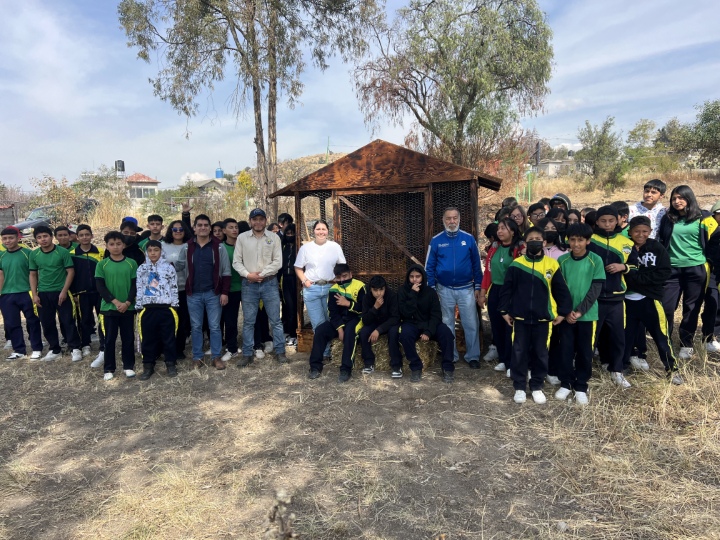Alumna Educates Youth on Agroecology Through USDA Fellowship in Mexico

By Lauren McEwen (Agricultural Communication, ’25)
In Texcoco, part of the sprawling suburbs outside Mexico City, a group of recent college graduates spent a year working with local youth to teach agriculture and leadership development. The teachers, part of the International Agricultural Education Fellowship Program (IAEFP), were assigned to six elementary and middle schools in central Mexico. Among them was Cal Poly alumna Sophia Garcia (Agricultural Science, ’23; Master of Agricultural Education, ’24), who just completed an 11-month fellowship in the city.
In Mexico, Garcia described a trend of declining investment in agriculture, where more and more people are leaving the agriculture industry to seek work in technology, retail, healthcare and other areas. “We were in an urban area where people are straying away from agricultural sectors,” Garcia said. “Through the fellowship, students have become more aware about the importance of agriculture and are interested in pursuing fields related to it.”


 The fellowship, funded by the United States Department of Agriculture, was established in 2018 to promote agriculture to primary and middle school students in Mexico, Guatemala and Ghana by sending U.S. citizens with degrees in agriculture to work with youth in these regions. The University of Missouri partners with the USDA through an extension program to collect research on the work done by the fellows serving in Mexico.
The fellowship, funded by the United States Department of Agriculture, was established in 2018 to promote agriculture to primary and middle school students in Mexico, Guatemala and Ghana by sending U.S. citizens with degrees in agriculture to work with youth in these regions. The University of Missouri partners with the USDA through an extension program to collect research on the work done by the fellows serving in Mexico.
Agriculture Abroad
Garcia was among eight fellows chosen from across the United States to promote agriculture programs, leadership and youth development in Texcoco. Garcia worked with first, second and third graders, as well as middle school students.
“When I came to the schools, the students didn’t have a concept of leadership in class. We had to show them that they themselves can become leaders in the community to provide a farm to fork experience,” she said.
Activities with the elementary school students included lessons on plant anatomy, the role of pollinators, how to create and maintain a garden, and the use of sustainable, natural inputs such as compost and crop association. “We taught the importance of maintaining cultural agriculture practices,” she said, while striving to stay away from industrial farming techniques.
Garcia and her peers also developed an animal science club covering a breadth of livestock production methods, animal husbandry and other practical skills. Students learned how to make ice cream, as well as understand the importance of livestock ear notching, anatomy and diet. “We tried to make it really interactive because we know that students are more engaged that way,” she said. The students also tended a flock of chickens, had an egg production enterprise, cared for pollinator and medicinal gardens, and maintained a compost program.
The fellowship facilitated other unique learning opportunities for the students. Garcia shared that she and her students took a four-day trip around the country, visiting various agricultural productions including an apiary, greenhouses, chili and tomato growers and exporters of other agricultural commodities. Additionally, college students from the Universidad Autónoma Chapingo, Mexico’s leading agriculture university, volunteered with the fellows to increase the youth’s exposure to individuals with diverse agricultural backgrounds.
Learn by Doing in Action
The lesson plans are modeled after 4H and Future Farmers of America curricula where students complete projects with a Learn by Doing foundation. Garcia’s own Cal Poly education has been integral to her experience as an educator.
“My agricultural science degree provided a good foundation for every field in my fellowship, especially by taking hands-on courses with labs. I was able to apply these courses to my own classes at the fellowship,” she said. “The Master of Agricultural Education program prepared me to work with students on lesson plans, while the teaching pedagogy prepared me for the education and communication part.”
One aspect of her Cal Poly experience that was particularly useful was her active membership in the Latinos in Agriculture (LIA) Club. She said the annual youth conference “26 Hours of Science and Technology in Agriculture,” hosted for high school students each year by LIA at Cal Poly, is very similar to the fellowship and prepared her for the teaching pathway.
Garcia said that while the IAEFP was incredibly empowering for the students she taught, the program has had a profound impact on her as well. “It is really rewarding to get to help my roots,” she said. “Now I see myself working at a middle school, which opened my eyes for opportunities to help students within agriculture. It was humbling to see how opportunities can grow in the ag sector despite limited resources.”
Mexico and the United States have a significant export-import relationship that hinges on agricultural production in both countries. “Mexico has a federal inspection organization that wants to continue that partnership with America in disease prevention and boost economic activity,” she said. “The International Agricultural Education Fellowship Program is important so that students know they can work with the United States and Mexico to support their local communities.”
The eight fellows presented their findings to key stakeholders in Washington, D.C. during the first week of June. While the program is funded through year’s end, there is some uncertainty if funding will continue to be renewed. Garcia said she is hopeful that her presentation had an impact and is demonstrating the program’s value for all involved.
“Hopefully, through our presentations they were able to see the potential in creating future leaders and understand the value of working with those who are different than you to help agriculture as a whole,” Garcia said.
Visit Cultivate Summer 2025 to read more stories.